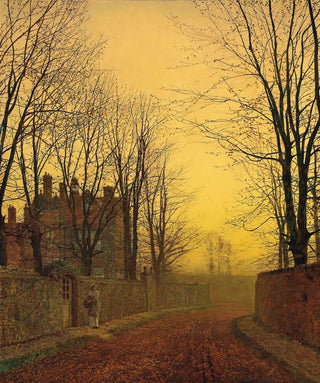Art print | An Autumn Alley (Conflict of Cases) - John Atkinson Grimshaw


View from behind

Frame (optional)
In the fascinating world of art, some works stand out for their ability to capture the very essence of a fleeting moment. "An Autumn Alley (Conflict of Cases) - John Atkinson Grimshaw" is one of these creations. It evokes a walk through an autumn landscape, where golden leaves intertwine with delicate shadows. The piece transports us into a melancholic atmosphere, where time seems to stand still. Every brushstroke tells a story, an invitation to contemplation. By immersing ourselves in this scene, Grimshaw invites us to discover the ephemeral beauty of nature, while awakening a sense of nostalgia within us.
Style and uniqueness of the work
John Atkinson Grimshaw's style is characterized by striking realism, combined with poetic sensitivity. In "An Autumn Alley," he uses warm tones and play of light to create an ambiance that is both serene and mysterious. The majestic trees, with their sturdy trunks, stand proudly, while the winding path, bordered by fallen leaves, appears to guide us toward a calming unknown. The artist masters the art of perspective, offering depth that draws us into the heart of the scene. The meticulous details, from reflections on the wet cobblestones to the nuances of the foliage, testify to exceptional craftsmanship. Grimshaw thus manages to transform a simple landscape into a true visual experience, where each element contributes to the harmony of the whole.
The artist and his influence
John Atkinson Grimshaw, born in 1836, is often regarded as one of the masters of the Pre-Raphaelite movement, although he developed a style that is uniquely his own. His passion for nature and talent for capturing light allowed him to make a name for himself in the Victorian art world. Grimshaw drew inspiration from British landscapes, while incorporating an almost mystical dimension into his works. His influence extends beyond his era, inspiring many contemporary and modern artists. By exploring themes of nature, light, and emotion, he opened the

Matte finish

View from behind

Frame (optional)
In the fascinating world of art, some works stand out for their ability to capture the very essence of a fleeting moment. "An Autumn Alley (Conflict of Cases) - John Atkinson Grimshaw" is one of these creations. It evokes a walk through an autumn landscape, where golden leaves intertwine with delicate shadows. The piece transports us into a melancholic atmosphere, where time seems to stand still. Every brushstroke tells a story, an invitation to contemplation. By immersing ourselves in this scene, Grimshaw invites us to discover the ephemeral beauty of nature, while awakening a sense of nostalgia within us.
Style and uniqueness of the work
John Atkinson Grimshaw's style is characterized by striking realism, combined with poetic sensitivity. In "An Autumn Alley," he uses warm tones and play of light to create an ambiance that is both serene and mysterious. The majestic trees, with their sturdy trunks, stand proudly, while the winding path, bordered by fallen leaves, appears to guide us toward a calming unknown. The artist masters the art of perspective, offering depth that draws us into the heart of the scene. The meticulous details, from reflections on the wet cobblestones to the nuances of the foliage, testify to exceptional craftsmanship. Grimshaw thus manages to transform a simple landscape into a true visual experience, where each element contributes to the harmony of the whole.
The artist and his influence
John Atkinson Grimshaw, born in 1836, is often regarded as one of the masters of the Pre-Raphaelite movement, although he developed a style that is uniquely his own. His passion for nature and talent for capturing light allowed him to make a name for himself in the Victorian art world. Grimshaw drew inspiration from British landscapes, while incorporating an almost mystical dimension into his works. His influence extends beyond his era, inspiring many contemporary and modern artists. By exploring themes of nature, light, and emotion, he opened the






